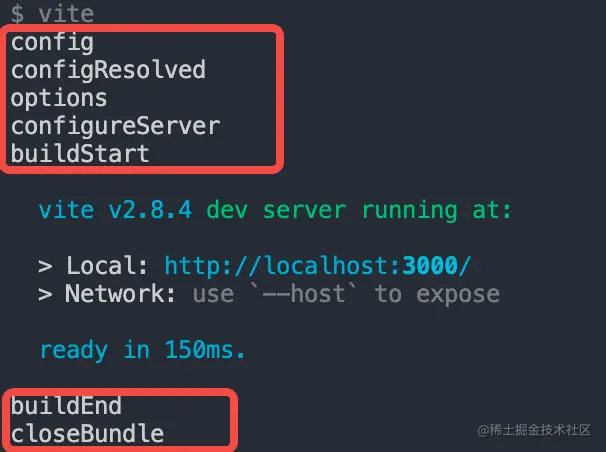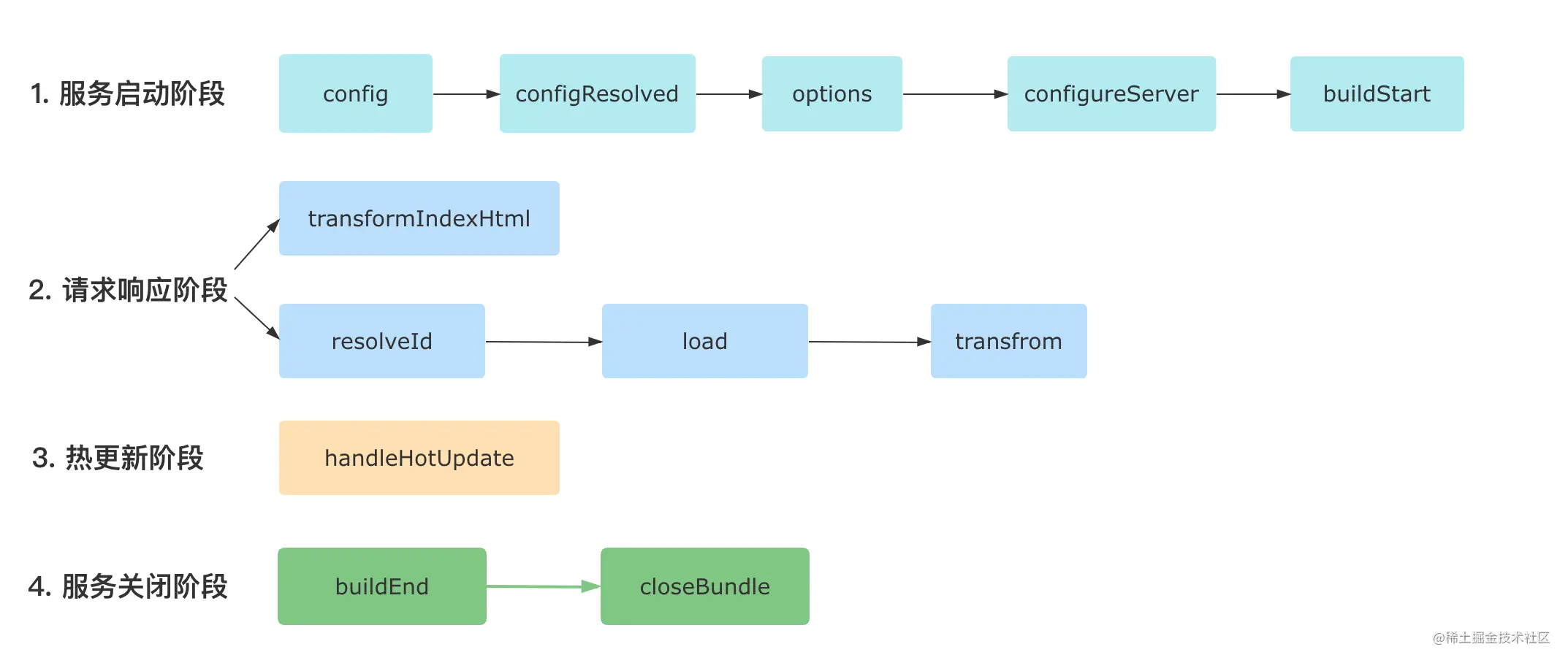# Vite Plugin
虽然 Vite 的插件机制是基于 Rollup 来设计的,并且上一小节我们也已经对 Rollup 的插件机制进行了详细的解读,但实际上 Vite 的插件机制也包含了自己独有的一部分,与 Rollup 的各个插件 Hook 并非完全兼容。
# 插件 Hook 介绍
# 通用 Hook
Vite 会调用一系列与 Rollup 兼容的钩子,这个钩子主要分为三个阶段:
- 服务器启动阶段: options 和 buildStart 钩子会在服务启动时被调用。
- 请求响应阶段: 当浏览器发起请求时,Vite 内部依次调用 resolveId、load和transform 钩子。
- 服务器关闭阶段: Vite 会依次执行 buildEnd 和 closeBundle 钩子。
除了以上钩子,其他 Rollup 插件钩子(如moduleParsed、renderChunk)均不会在 Vite 开发阶段调用。而生产环境下,由于 Vite 直接使用 Rollup,Vite 插件中所有 Rollup 的插件钩子都会生效。
# 独有 Hook
# 给配置再加点料: config
Vite 在读取完配置文件(即vite.config.ts)之后,会拿到用户导出的配置对象,然后执行 config 钩子。在这个钩子里面,你可以对配置文件导出的对象进行自定义的操作:
// 返回部分配置(推荐)
const editConfigPlugin = () => ({
name: 'vite-plugin-modify-config',
config: () => ({
alias: {
react: require.resolve('react')
}
})
})
2
3
4
5
6
7
8
9
官方推荐的姿势是在 config 钩子中返回一个配置对象,这个配置对象会和 Vite 已有的配置进行深度的合并。
# 记录最终配置: configResolved
Vite 在解析完配置之后会调用 configResolved 钩子,这个钩子一般用来记录最终的配置信息,而不建议再修改配置,用法如下图所示:
const exmaplePlugin = () => {
let config
return {
name: 'read-config',
configResolved(resolvedConfig) {
// 记录最终配置
config = resolvedConfig
},
// 在其他钩子中可以访问到配置
transform(code, id) {
console.log(config)
}
}
}
2
3
4
5
6
7
8
9
10
11
12
13
14
15
16
17
# 获取 Dev Server 实例: configureServer
这个钩子仅在开发阶段会被调用,用于扩展 Vite 的 Dev Server,一般用于增加自定义 server 中间件,如下代码所示:
const myPlugin = () => ({
name: 'configure-server',
configureServer(server) {
// 姿势 1: 在 Vite 内置中间件之前执行
server.middlewares.use((req, res, next) => {
// 自定义请求处理逻辑
})
// 姿势 2: 在 Vite 内置中间件之后执行
return () => {
server.middlewares.use((req, res, next) => {
// 自定义请求处理逻辑
})
}
}
})
2
3
4
5
6
7
8
9
10
11
12
13
14
15
# 转换 HTML 内容: transformIndexHtml
这个钩子用来灵活控制 HTML 的内容,你可以拿到原始的 html 内容后进行任意的转换:
const htmlPlugin = () => {
return {
name: 'html-transform',
transformIndexHtml(html) {
return html.replace(
/<title>(.*?)</title>/,
`<title>换了个标题</title>`
)
}
}
}
// 也可以返回如下的对象结构,一般用于添加某些标签
const htmlPlugin = () => {
return {
name: 'html-transform',
transformIndexHtml(html) {
return {
html,
// 注入标签
tags: [
{
// 放到 body 末尾,可取值还有`head`|`head-prepend`|`body-prepend`,顾名思义
injectTo: 'body',
// 标签属性定义
attrs: { type: 'module', src: './index.ts' },
// 标签名
tag: 'script',
},
],
}
}
}
}
2
3
4
5
6
7
8
9
10
11
12
13
14
15
16
17
18
19
20
21
22
23
24
25
26
27
28
29
30
31
32
33
# 热更新处理: handleHotUpdate
这个钩子会在 Vite 服务端处理热更新时被调用,你可以在这个钩子中拿到热更新相关的上下文信息,进行热更模块的过滤,或者进行自定义的热更处理
const handleHmrPlugin = () => {
return {
async handleHotUpdate(ctx) {
// 需要热更的文件
console.log(ctx.file)
// 需要热更的模块,如一个 Vue 单文件会涉及多个模块
console.log(ctx.modules)
// 时间戳
console.log(ctx.timestamp)
// Vite Dev Server 实例
console.log(ctx.server)
// 读取最新的文件内容
console.log(await read())
// 自行处理 HMR 事件
ctx.server.ws.send({
type: 'custom',
event: 'special-update',
data: { a: 1 }
})
return []
}
}
}
// 前端代码中加入
if (import.meta.hot) {
import.meta.hot.on('special-update', (data) => {
// 执行自定义更新
// { a: 1 }
console.log(data)
window.location.reload();
})
}
2
3
4
5
6
7
8
9
10
11
12
13
14
15
16
17
18
19
20
21
22
23
24
25
26
27
28
29
30
31
32
33
以上就是 Vite 独有的五个钩子,我们来重新梳理一下:
config: 用来进一步修改配置。configResolved: 用来记录最终的配置信息。configureServer: 用来获取Vite Dev Server实例,添加中间件。transformIndexHtml: 用来转换 HTML 的内容。handleHotUpdate: 用来进行热更新模块的过滤,或者进行自定义的热更新处理。
# 插件 Hook 执行顺序
// test-hooks-plugin.ts
// 注: 请求响应阶段的钩子
// 如 resolveId, load, transform, transformIndexHtml在下文介绍
// 以下为服务启动和关闭的钩子
export default function testHookPlugin () {
return {
name: 'test-hooks-plugin',
// Vite 独有钩子
config(config) {
console.log('config');
},
// Vite 独有钩子
configResolved(resolvedCofnig) {
console.log('configResolved');
},
// 通用钩子
options(opts) {
console.log('options');
return opts;
},
// Vite 独有钩子
configureServer(server) {
console.log('configureServer');
setTimeout(() => {
// 手动退出进程
process.kill(process.pid, 'SIGTERM');
}, 3000)
},
// 通用钩子
buildStart() {
console.log('buildStart');
},
// 通用钩子
buildEnd() {
console.log('buildEnd');
},
// 通用钩子
closeBundle() {
console.log('closeBundle');
}
}
2
3
4
5
6
7
8
9
10
11
12
13
14
15
16
17
18
19
20
21
22
23
24
25
26
27
28
29
30
31
32
33
34
35
36
37
38
39
40
41
各个 Hook 的执行顺序:

由此我们可以梳理出 Vite 插件的执行顺序:

- 服务启动阶段:
config、configResolved、options、configureServer、buildStart - 请求响应阶段: 如果是
html文件,仅执行transformIndexHtml钩子;对于非 HTML 文件,则依次执行resolveId、load和transform钩子。相信大家学过 Rollup 的插件机制,已经对这三个钩子比较熟悉了。 - 热更新阶段: 执行
handleHotUpdate钩子。 - 服务关闭阶段: 依次执行
buildEnd和closeBundle钩子。
# 插件应用位置
Vite 中插件的执行顺序如下图所示:

Vite 会依次执行如下的插件:
- Alias (路径别名)相关的插件。
- 带有
enforce: 'pre'的用户插件。 - Vite 核心插件。
- 没有 enforce 值的用户插件,也叫
普通插件。 - Vite 生产环境构建用的插件。
- 带有
enforce: 'post'的用户插件。 - Vite 后置构建插件(如压缩插件)。
